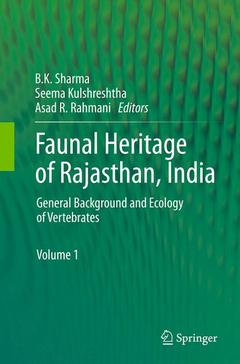Description
Faunal Heritage of Rajasthan, India, Softcover reprint of the original 1st ed. 2013
General Background and Ecology of Vertebrates
Coordinators: Sharma B.K., Kulshreshtha Seema, Rahmani Asad R.
Language: English
Subjects for Faunal Heritage of Rajasthan, India:
Keywords
Thar Desert; UNESCO; desert; fauna; tiger reserve; vertebrate; Fish and Wildlife Biology
Support: Print on demand
645 p. · 15.5x23.5 cm · Paperback
Description
/li>Contents
/li>Comment
/li>
This is the first ever monumental and scientific documentation of the faunal wealth of the Indian Desert state of Rajasthan. This volume, the first of two, provides background on Rajasthan and covers species diversity and distribution of fauna. A scholarly contribution to the field of knowledge, it provides novel and vital information on the vertebrate faunal heritage of India?s largest state.
Broadly falling under the Indo-Malaya Ecozone, the three major biomes of Rajasthan include deserts and xeric shrublands, tropical and subtropical dry broadleaf forests, and tropical and subtropical moist broadleaf forests. The corresponding ecoregions to the above biomes are, respectively, the Thar Desert and northwestern thorn scrub forests, the Khathiar-Gir dry deciduous forests, and the Upper Gangtic Plains moist deciduous forests. Contrary to popular belief, the well-known Thar or Great Indian Desert occupies only a part of the state. Rajasthan is diagonally divided by the Aravallimountain ranges into arid and semi-arid regions. The latter have a spectacular variety of highly diversified and unique yet fragile ecosystems comprising lush green fields, marshes, grasslands, rocky patches and hilly terrains, dense forests, the southern plateau, fresh water wetlands, and salt lakes.
Apart from the floral richness, there is faunal abundance from fishes to mammals. In this volume, the various flagship and threatened species are described in the 24 chapters penned by top notch wildlife experts and academics. The world famous heronry, tiger reserves, wildlife sanctuaries and some threat-ridden biodiversity rich areas shall certainly draw the attention of readers from around the world.
Dedication-1.- Dedication-2.- Foreword.- Preface.- Acknowledgements.- Table of Contents.- Contributors.- Part I: Unveiling the Vivacious Rajasthan.- The Majestic Rajasthan: An Introduction.- Physiography and Biological Diversity of Rajasthan.- Historical, Socio-cultural and Mythological Aspects of Faunal Conservation in Rajasthan.- An Anthropological Account of Bonhomie and Opprobrium between Communities and Animals in Rajasthan.- Fossil Records of Rajasthan-. Part II: Faunal Ecology: An Insight-Piscifauna and Herpetofauna.- Ichthyofauna of Rajasthan.- Chelonian Status and Conservation in Rajasthan.- Important species of Lizards in the Thar Desert of Rajasthan.- Natural History Observations on the Indian Spiny-tailed Lizard (Uromastyx hardwickii) in the Thar Desert.- Ophidians of Rajasthan.- Part III: Faunal Ecology: An Insight-Avifauna.- Conservation of Bustards with Special Reference to Great Indian Bustard (Ardeotis nigriceps): The State Bird of Rajasthan.- Distribution, Status and Conservation of Lesser Florican Spheotidesindica in Rajasthan.- Status and Distribution of Raptors in Rajasthan.- White-napped Tit Parus nuchalis - A vulnerable Species in Rajasthan.- Part IV: Faunal Ecology: An Insight-The Mammal Conglomerate.- Non-human Primates of Rajasthan.- Status of Tiger in Rajasthan.- Status, Distribution and Conservation of Leopard (Panthera pardus fusca) in Rajasthan.- Small Cats of Rajasthan.- Major Canids of Rajasthan.- TheStatus and Conservation of Sloth Bears in Rajasthan.- Chiropteran Fauna of Rajasthan-Taxonomy, Distribution and Status.- Non-Volant Small Mammals of Rajasthan.- Squirrels of Rajasthan with special reference to Elliot’s Giant Flying Squirrel Petaurista petaurista philippensis.-Wild Ungulates in Rajasthan.- Appendices.- Glossary.- Further Reading.- Index.- The Book and Its Audience.- About the Editors.




